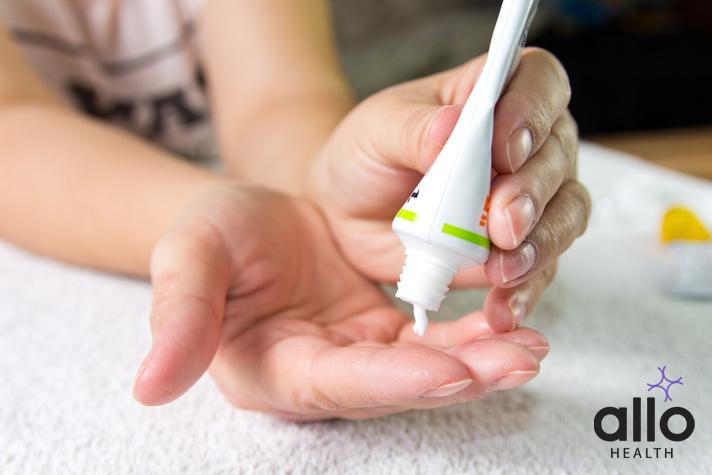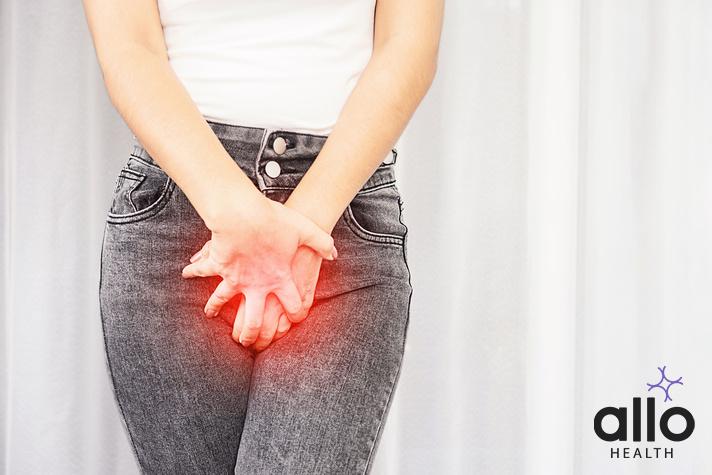Benefits of Cream for Vaginal Burning

Allo Health is dedicated to personalized well-being, offering support and trusted information tailored to individual health goals. The platform emphasizes human-generated content, led by a distinguished medical team of experts, including physicians and sexual health specialists. Their commitment to credibility involves rigorous fact-checking, authoritative research, and continuous updates to ensure accurate, up-to-date information. Allo Health's unique approach goes beyond conventional platforms, providing expert-led insights and a continuous commitment to excellence, with user feedback playing a crucial role in shaping the platform's authoritative voice.

Dr Sanina Mansoor holds MBBS degree from Yenepoya university,Mangalore.She has 8 years of experience working as a medical officer at various health centres and medical colleges.
Why This Was Upated?
Our experts continually monitor the health and wellness space, and we update our articles when new information became available.
Updated on 10 April, 2024
- Article was updated as part of our commitment to diversity, equity, and inclusion.

"The following blog article may discuss medical treatments and interventions. However, it is important to note that the information provided is for general educational purposes only and should not be considered as a substitute for professional medical advice, diagnosis, or treatment. Always seek the guidance of a qualified healthcare professional for personalized medical advice.
Book consultation
Medical treatments are complex and should be tailored to individual circumstances. The information presented in this blog may not be applicable to everyone, as each person's medical condition, history, and needs are unique. Only a qualified healthcare professional can evaluate your specific medical situation, consider relevant factors, and provide appropriate recommendations for diagnosis, treatment options, and monitoring.
It is crucial to note that self-diagnosis, self-medication, or relying solely on the information provided in this blog for treatment decisions can have serious health consequences. "
Vaginal burning can be a distressing symptom, often pointing towards various health conditions. This article aims to provide information about the causes, symptoms, and treatment options for this condition with the cream for vaginal burning available.
What are The Causes of Vaginal Burning
Vaginal burning, a common and often uncomfortable symptom, can be caused by a variety of factors:
- Vaginal Infection: Often results from yeast infections or bacterial vaginosis, leading to inflammation and burning.
- Urinary Tract Infections (UTIs): These can cause a burning sensation, especially during urination, cloudy urine, and frequent urge to urinate.
- Fungal Infection: Yeast infections are a typical example, causing redness, and burning. Besides burning, there might be a thick, white discharge, similar to cottage cheese, and severe itching.
- Hormone Therapies and Hormonal Changes: Hormonal fluctuations, especially during menopause, can lead to vaginal dryness and irritation, exacerbating burning sensations.
- Allergic Reactions or Chemical Irritation: Products like detergents, soaps, or even certain fabrics can cause contact dermatitis, leading to burning, itching, and redness.
- Sexual Intercourse: Sometimes, friction during intercourse can cause or exacerbate burning sensations, especially if there’s inadequate lubrication or an underlying condition.
- Inflammatory Disease: Conditions like pelvic inflammatory disease can contribute to burning sensations in the genital region along with abdominal pain and abnormal discharge.
- Genital Herpes: This sexually transmitted infection can cause painful, burning lesions in the genital area.
- Skin Conditions: Certain skin conditions, such as contact dermatitis, can cause burning and irritation in the vaginal area.
- Vaginal Atrophy: Commonly occurring during menopause, this condition leads to thinning and inflammation of the vaginal walls, causing burning, itching, and painful intercourse.
- Bacterial Infection: Apart from vaginal infections, other types of bacterial skin infections can also cause burning sensations.
In any case, if you experience persistent or severe vaginal burning, it’s important to consult a healthcare provider to accurately diagnose and treat the underlying cause.
Different Creams Available for Vaginal Burning
There are several types of creams available to address vaginal burning, each targeting different underlying causes. These creams can be broadly categorized based on their active ingredients and intended use:
- Antifungal Creams
- Specifically designed to treat yeast infections (vaginal yeast Infection), a common cause of vaginal burning.
- Examples include creams containing clotrimazole, miconazole, or terconazole.
- These are effective treatments for the fungal infection causing symptoms like itching, burning, and abnormal discharge.
- Antibiotic Creams
- Used for bacterial infections, including bacterial vaginosis and some sexually transmitted infections.
- Often prescribed by healthcare providers to treat bacterial causes of vaginal burning and discomfort.
- Hormone Therapies
- Hormonal creams, often containing estrogen, are used for treating vaginal atrophy, especially in postmenopausal women.
- They help in restoring the normal vaginal environment, reducing symptoms like dryness, itching, and burning.
- Creams for Vulvar Itching and Burning
- These creams are formulated to relieve external discomfort in the genital region.
- They might include mild steroids to reduce inflammation and itching.
- Over The Counter (OTC) Creams
- These are available without a prescription and can provide temporary relief from mild itching and burning.
- It’s important to choose products designed for sensitive skin and to avoid those with potential allergens or irritants.
- Herbal and Natural Creams
- Some individuals opt for herbal or natural creams that contain ingredients like aloe vera or tea tree oil.
- These can be soothing for sensitive skin and minor irritations but should be used with caution as they can also cause allergic reactions in some people.
It’s crucial to identify the underlying cause of vaginal burning before selecting a cream. A healthcare provider can offer guidance and may recommend specific medical treatments based on the type of infection or condition causing the symptoms. Proper diagnosis is key, as using the wrong type of cream can exacerbate symptoms or lead to persistent itching, severe itching, and further discomfort. Additionally, maintaining proper hygiene and avoiding everyday products that may cause irritation or allergic reactions can help prevent recurrent issues.
Benefits of Cream for Vaginal Burning

Creams designed for vaginal burning offer several benefits, particularly when dealing with discomforts caused by various conditions like vaginal infections, yeast infections, and hormonal changes. Here’s how they help:
- Soothe Vaginal Itching and Burning: Creams can provide immediate relief from the uncomfortable symptoms of vaginal burning and itching, common in conditions like yeast infections and allergic reactions.
- Treat Infections: Many vaginal creams contain antifungal or antibiotic properties, making them effective in treating yeast infections and bacterial infections. They work directly at the infection site, reducing symptoms and eradicating the infection.
- Relief from Urinary Tract Infections (UTIs): Some creams can help alleviate the burning sensation associated with UTIs, though they are not a substitute for systemic treatment of the infection itself.
- Reduce Inflammation: Ingredients in these creams can help reduce inflammation and discomfort, especially in cases of inflammatory diseases or skin conditions affecting the genital region.
- Alleviate Symptoms of Hormonal Changes: Hormone therapies in the form of vaginal creams can help manage symptoms related to menopause, such as vaginal atrophy, which causes dryness and burning.
- Prevent Further Irritation: By providing a protective barrier, these creams can prevent further irritation from contact dermatitis or direct contact with irritants found in everyday products.
- Improve Comfort During Sexual Intercourse: By alleviating vaginal dryness and discomfort, these creams can make sexual intercourse more comfortable, especially in cases of vaginal atrophy or after treatment for infections.
- Enhance Vaginal Health: Some creams also support the balance of vaginal microflora, which is crucial for maintaining vaginal health and preventing recurrent infections.
It’s important to choose the right type of cream based on the underlying cause of vaginal burning. Consulting a healthcare provider is essential for an accurate diagnosis and to determine the most effective treatment, whether it’s an over-the-counter cream, prescription medication, or a combination of medical treatments and lifestyle adjustments.
Alternatives Treatment Options

For treating vaginal burning, there are several alternatives to creams that can be effective. These include:
Oral Medications
- Antifungal Medicine: Especially for yeast infections.
- Antibiotics: Used to treat bacterial infections, including urinary tract and bladder infections.
Hormone Therapies
- Hormone Pills or Patches: To address vaginal atrophy or hormonal imbalances.
Home Remedies and Lifestyle Changes
- Warm Water Baths: Can soothe the genital region.
- Wearing Cotton Underwear: To reduce moisture and irritation.
- Avoiding Irritants: Such as scented soaps or vaginal products that can cause contact dermatitis.
Probiotic Supplements
- Maintain Vaginal Microflora: Helpful in preventing and treating bacterial and yeast infections.
Herbal Products
- Natural Anti-Inflammatory and Antimicrobial Agents: May provide relief from symptoms.
Medical Procedures
- For Chronic Conditions: Like vaginal atrophy, certain medical procedures might be recommended.
Consulting a Health Care Provider
- Proper Diagnosis: To identify the exact cause of vaginal burning.
- Personalized Treatment Plan: Based on the type of infection or medical condition.
Avoiding Sexual Contact
- During Active Infections: To prevent worsening of symptoms and spreading the infection.
It’s essential to identify the underlying cause of vaginal burning to choose the most effective treatment. Consulting with a healthcare provider is crucial for an accurate diagnosis and appropriate treatment plan.
Conclusion
Vaginal burning is a symptom that can arise from various causes, ranging from infections to hormonal changes. Understanding these causes, recognizing symptoms, and knowing when to seek medical advice are crucial steps in effectively managing and treating this condition. Remember, while over-the-counter creams can offer relief, consulting a healthcare provider for proper diagnosis and treatment is always recommended.
Most Asked Questions
-
What causes vaginal burning and how can creams help?
Vaginal burning can be caused by infections like yeast or bacterial infections, hormonal changes, or allergic reactions to products. Creams specifically designed to treat these conditions can help soothe the burning sensation and address the underlying issue, whether it's an infection or irritation.
-
When should I see a healthcare provider for vaginal burning?
It's important to consult a healthcare provider if the burning is persistent, severe, accompanied by abdominal pain, or unusual discharge. They can diagnose the issue properly and suggest the right treatment, including prescribing the appropriate cream or other medications.
-
Are over-the-counter creams safe for treating vaginal burning?
Over-the-counter creams, especially antifungal and antibiotic ones, can be effective for treating common causes of vaginal burning. However, it's crucial to read the labels and understand what each cream is for. If you're unsure, ask a pharmacist or your healthcare provider for advice.
-
How can I prevent vaginal burning in the future?
Maintaining proper hygiene with gentle washing, wearing breathable cotton underwear, and avoiding direct contact with irritants like harsh soaps or scented products can help prevent vaginal burning. Also, being mindful of your body's reactions to different products and changing habits accordingly can reduce the risk of future discomfort.






































